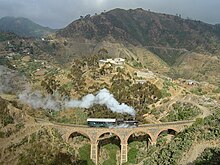Italian colonial railways

The Italian colonial railways started with the opening in 1888 of a short section of line in
History


The first rail lines were built mainly for war needs in the absence of efficient means of communication in the occupied territories, after the conquests of Eritrea and Libya. However, were quite limited in the first decades of occupation. In 1940 the amount of railways in operation, between Italian East Africa and Libya, amounted to 1,556 km of which, however, the 693 km of the Italian section of the Railway Djibouti-Addis Ababa were pre-existing and built by the French Empire for Ethiopia.
The railways were built by Italy from the outset with little potential, because built with narrow gauge rails and with light metal type, and were never of great economic importance because isolated from the lines of neighboring states. Indeed, the choice of a
Projects
In 1940 there were some projects of new colonial railways in the Italian Empire:
- Tripoli-Benghazi in Libya (1,000 km in construction since summer 1941)[2]
- Tripoli-border Tunisia (in construction since June 1941)
- Assab-Dire Dawa in Ethiopia & Eritrea
- Kassala-Agordat in Eritrea & Sudan[3]
Two international projects were studied for decades, but never done because of excessive financial difficulties:
- Italian "Transaharan railway" (Tripoli-Tchad/Camerun) between Libia and the Gulf of Guinea[4]
- Asmara-Addis Abeba-Mogadiscio (since the 1890s projected and allowed by international Treaties)[5]
All these projects were stopped by the
Italian colonial railways resumen
In 1940 the Italian colonial railways had 1,561 km and were the following:

| Railway name | Km | Years when built | Colony |
|---|---|---|---|
| Addis Abeba–Gibuti | 684 kmOnly Ethiopia section | 1902-1917 | Africa Orientale Italiana (Ethiopia)
|
| Asmara–Biscia | 227 km | 1914–1932 | Africa Orientale Italiana (Eritrea)
|
| Bengasi–Soluch | 56 km | 1926 | |
| Bengasi–Barce | 108 km | 1914–1927 | |
| Massaua–Asmara | 118 km | 1901–1911 | Africa Orientale Italiana (Eritrea)
|
| Massaua–Saati | 26 km | 1886–1887 | Africa Orientale Italiana (Eritrea)
|
| Mogadiscio–Villaggio Duca degli Abruzzi | 113 km | 1924–1927 | Africa Orientale Italiana (Somalia)
|
| Tripoli–Tagiura | 21 km | 1912 | |
| Tripoli–Vertice 31 | 90 km | 1912–1915 | |
| Tripoli–Zuara | 118 km | 1912–1919 | |
| Ferrovie coloniali italiane (Italian colonial railways) | 1,561 km |
With the above railways there were some decauville railways, like:
- Mersa Matuma–Kululi (. A Decauville gauge line was built in 1905 by the Italians inside the port of Mersa Fatuma and from it into the hinterland until Kululi (called "Colulli" in Italian) near the Ethiopian border.
- Villabruzzi–Ferfer (
- Genale–Afgoi (Italian Somalia). In 1924, a minor railway was built in the area just west of on the Mogadishu-Villagio Duca degli Abruzzi route. Construction was managed by the "Società Agricola Italo Somala" (SAIS), which opened the track so that its plantations' powered sugar cane could be transported to the Mogadishu Port.
See also
- Eritrean Railway
- Mogadishu-Villabruzzi Railway
- Ferrovie dello Stato
References
- ^ Astuto 1941, p. 30.
- ^ S. Maggi:"Le Ferrovie nell'Africa italiana"; p.23
- ^ Gatti; p.21
- ^ Astuto, Riccardo; p.34
- ^ Astuto, Riccrdo; p.45
- ^ Maggi; p.9
Bibliography
- Astuto, Riccardo (1941). "Questioni ferroviarie africane". Rassegna Economica dell'Africa Italiana. XXIX. Roma.
- Basuyau, Vincent (1991). Le chemin de fer de Djibouti à Addis Abeba (Mémoire de DEA). Paris: Université de Paris I-Panthéon Sorbonne.
- Crozet, Jean Pierre. "The Franco Ethiopian and Djibouty Ethiopian railway" (Detailed Website on the Addis Abeba-Djibouti railway)
- Gatti, G. (1975). Le ferrovie coloniali italiane. Roma: Ed. GRAF.

